We now know that the joint
inquiry into the Tesco and Buyright applications will start on the 31st
October and will last about 12 days.
The inquiry will be conducted
by Mrs Wood, who we understand has a background in conservation. There will be
three barristers involved, representing Tesco, QD Stores (Buyright) and
Babergh.
Ken Turner, the MD of QD
Stores has brought together a strong team of experts who will be strongly
opposing the Tesco application as well as promoting the Buyright case. This
team will be doing much of the work that we would have tried to do and with
much greater resources than we could dream of. Nevertheless, we still have a
part to play and your Society will be giving evidence at the inquiry to object
to the Tesco application and to support the QD Stores.(Buyright) application
Whilst the inspector will
have access to all the letters that have been written to the Council we are
advised that we should now send as many letters as possible directly to the
Planning Inspectorate, stating our objections to the Tesco application and
support for Buyright’s.
If you wish to speak at the
Inquiry itself then you should also write to the same address with details of
the points you wish to cover.
Letters should be sent to:
Mr Bob Palmer,
The Planning Inspectorate,
Room 11/00,
Tollgate House,
Houlton Street,
Bristol BS2 9DJ.
From the
Civic Trust’s Civic Society Briefing
Retailing In Town Centres
Following reports by The Civic Trust and other bodies
the Environment. Transport and Regional Affairs Committee is urging the
government not to amend its policies on retailing in town centres in the light
of the Competition Commission’s review. Instead the MPs called on the
government to strengthen PPG6 on retailing development. They recommend that
clarification is needed in defining suitable sites in town centres that must
be considered for development before an out of town scheme is approved. The
Competition Commission is due publish its findings shortly but has already
floated the idea that retail impact assessments should be independently
conducted. A single, independently produced report, based on mutually agreed
data, would result in more robust decision-making. Especially helpful would be
compulsory post-decision monitoring to check whether forecasts proved
accurate.
Lampposts
The Marlow Society has reported bulky lampposts erected
without proper consultation. The
District Council brushed aside requests to have them re-sited.
The Civic Trust is interested to hear of any other cases.
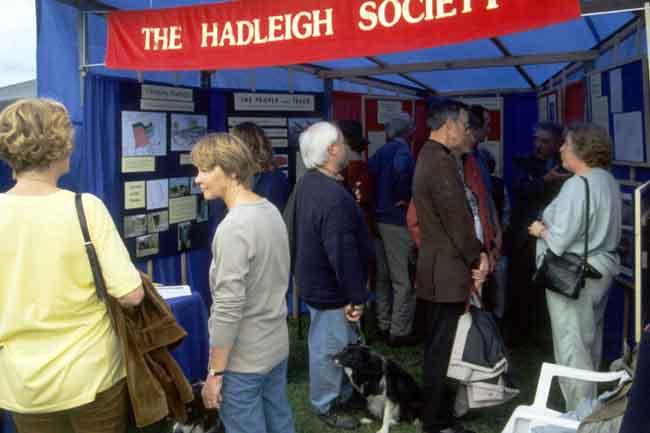 Over
the 4 years that the Hadleigh Society has had its own stand at the May Show it
has gone from strength to strength, due particularly to the work of Joe Byrne.
This year’s display was probably the most varied yet.
Whilst it was important to present the supermarket issue the wide range
of other interests were equally represented, covering the recent
archaeological finds, the history of the MoD site, and this year’s Noel
Turner Award.
Over
the 4 years that the Hadleigh Society has had its own stand at the May Show it
has gone from strength to strength, due particularly to the work of Joe Byrne.
This year’s display was probably the most varied yet.
Whilst it was important to present the supermarket issue the wide range
of other interests were equally represented, covering the recent
archaeological finds, the history of the MoD site, and this year’s Noel
Turner Award.
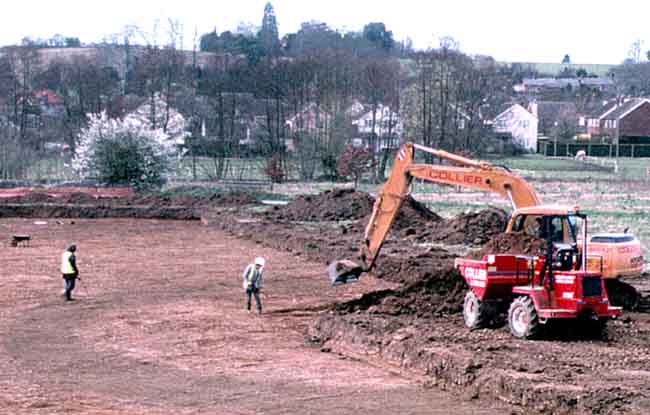 Land
at the junction of Boswell Lane and Aldham Mill Hill, Hadleigh, was the
subject of an archaeological excavation carried out by the Suffolk County
Council Archaeological Service. The project, which was funded by Persimmon
Homes, ran for nearly two months during which time, a number of interesting
discoveries were made.
Land
at the junction of Boswell Lane and Aldham Mill Hill, Hadleigh, was the
subject of an archaeological excavation carried out by the Suffolk County
Council Archaeological Service. The project, which was funded by Persimmon
Homes, ran for nearly two months during which time, a number of interesting
discoveries were made.
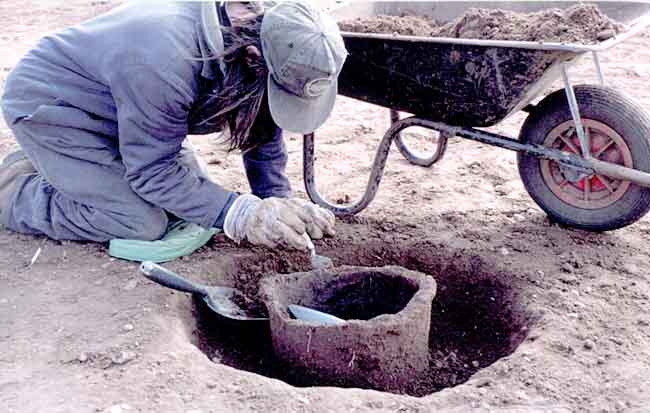 An
assessment of air photographs had identified two Bronze Age ring ditches
(around 3500 - 4000 years old) visible as cropmarks within the excavation
area. The southern ditch was around 2.5m in width and 1.5m deep and probably
had quite a large mound or barrow in the centre, created by the upcast of
spoil from the original digging of the encircling ditch. Such ring ditches are
associated with burials and/or cremations and whilst no Bronze Age burials
were found within the ditch, it is likely that at least one was contained
within the barrow itself. However, any mound was probably flattened centuries
ago, destroying evidence of the burial practices that once took place there.
An
assessment of air photographs had identified two Bronze Age ring ditches
(around 3500 - 4000 years old) visible as cropmarks within the excavation
area. The southern ditch was around 2.5m in width and 1.5m deep and probably
had quite a large mound or barrow in the centre, created by the upcast of
spoil from the original digging of the encircling ditch. Such ring ditches are
associated with burials and/or cremations and whilst no Bronze Age burials
were found within the ditch, it is likely that at least one was contained
within the barrow itself. However, any mound was probably flattened centuries
ago, destroying evidence of the burial practices that once took place there.
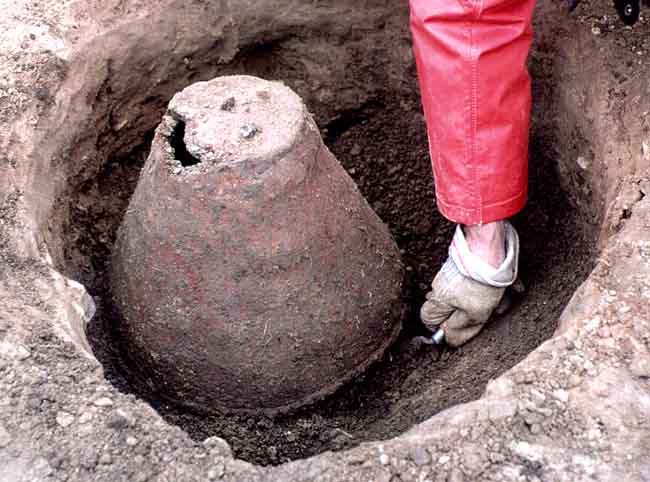 The
second ring ditch was shallower and much narrower than the first and probably
did not have such a large central mound. Within this ditch, a cluster of
around 30 cremations had survived, some of which contained hand-made ceramic
urns that held either cremated material or possible food offerings. Other
cremations showed signs that remains had been burnt in situ. A third, much
smaller ring ditch was not visible from air photos but was found to contain a
group of at least five cremations. All of these features produced bone
fragments that will be analysed by specialists, giving valuable clues about
the social groups that are represented here.
The
second ring ditch was shallower and much narrower than the first and probably
did not have such a large central mound. Within this ditch, a cluster of
around 30 cremations had survived, some of which contained hand-made ceramic
urns that held either cremated material or possible food offerings. Other
cremations showed signs that remains had been burnt in situ. A third, much
smaller ring ditch was not visible from air photos but was found to contain a
group of at least five cremations. All of these features produced bone
fragments that will be analysed by specialists, giving valuable clues about
the social groups that are represented here.
The site produced plenty of evidence to show that there
was prehistoric activity in the area from the Mesolithic period (c.8300 BC)
through to the Bronze Age. This took the form of occasional isolated features
and numerous worked flints scattered all over the site. However, no evidence
of settlement was found in the study area, although it is clear from the
distribution and number of finds, and from the burials themselves, that there
must have been some form of prehistoric settlement relatively close by.
 During
the seventh century, the ring ditches were used again as a focus for burial,
this time by the Anglo Saxons. Four graves were discovered, two male and two
female, producing a number of glass and ceramic beads, items of bronze and
silver jewellery, a spearhead and a complete pot which originally came from
the Rhineland region of Europe. Little bone was preserved in these graves as
the sandy soil was too acidic. Despite this, finding these graves offers us
important information about the ring ditch, indicating that it was still
somehow visible in the seventh century in order that the burials could focus
upon it. It is most likely that the mound survived rather than the ditch; one
grave lies half in the ditch and half out showing that by around 2000 years
after it was excavated, the ring ditch must have filled up, and may not have
been visible at all.
During
the seventh century, the ring ditches were used again as a focus for burial,
this time by the Anglo Saxons. Four graves were discovered, two male and two
female, producing a number of glass and ceramic beads, items of bronze and
silver jewellery, a spearhead and a complete pot which originally came from
the Rhineland region of Europe. Little bone was preserved in these graves as
the sandy soil was too acidic. Despite this, finding these graves offers us
important information about the ring ditch, indicating that it was still
somehow visible in the seventh century in order that the burials could focus
upon it. It is most likely that the mound survived rather than the ditch; one
grave lies half in the ditch and half out showing that by around 2000 years
after it was excavated, the ring ditch must have filled up, and may not have
been visible at all.
Aerial photos also picked out hints of a field system,
which was found during the dig to be part of a quite substantial agricultural
complex. This consisted mostly of boundary ditches forming trackways and
paddocks but also produced evidence of at least two buildings. However, they
were probably farm buildings, rather than dwellings since they do not appear
to have hearths or any sign of internal divisions
MoDern
History
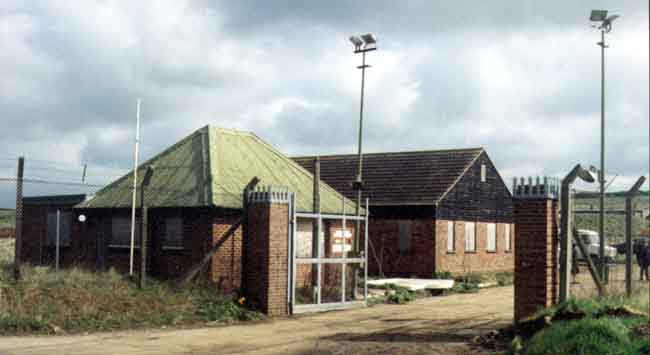 There
have been many stories of the massive underground chambers at the MOD site,
all once filled with High Explosives. Now
the secret is out. There are no
underground chambers, just three bunkers on the surface with large concrete
blocks for lorries to unload.
There
have been many stories of the massive underground chambers at the MOD site,
all once filled with High Explosives. Now
the secret is out. There are no
underground chambers, just three bunkers on the surface with large concrete
blocks for lorries to unload.
Each building is divided into a number of bays and has
a roller type conveyor running its length.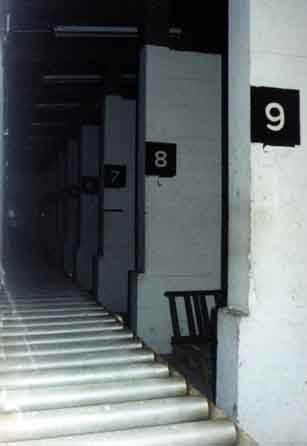 The roller tracks could be extended to the loading blocks to enable boxes to
be lifted off lorries, pushed along the rollers and then lifted off to be
stacked in one of the bays.
The roller tracks could be extended to the loading blocks to enable boxes to
be lifted off lorries, pushed along the rollers and then lifted off to be
stacked in one of the bays.
There are no signs of any lifting equipment; everything
had to be manhandled. It is
likely that only small-arms ammunition was ever stored there. We have it on good authority that the last contents of the
bunkers were Thunder Flashes and Baton Rounds.
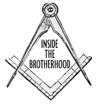 At
our April meeting, which saw one of the best attendances, Pat Lewis, wife of
one of the prominent Hadleigh Freemasons, gave us a very interesting insight
into the mysteries of freemasonry.
At
our April meeting, which saw one of the best attendances, Pat Lewis, wife of
one of the prominent Hadleigh Freemasons, gave us a very interesting insight
into the mysteries of freemasonry.
What is usually regarded as a secret society came alive
uncovered by Mrs. Pat Lewis who told us she was given all the help in her
researches by the Masonic Grand Lodge in London.
Pat explained the connection between the Angel Lodge
in Colchester and The Lodge, Virtue and Silence of Hadleigh, which was
founded in 1811. They used to meet on the nearest Wednesday to the full moon
so that visits by horse and cart could take place. Both were affected by the Napoleonic War.
After the war, Colchester, because of its position with a navigable
river to the sea and its good network of roads and the garrison; prospered at
a far greater pace than Hadleigh. When
the Hadleigh Lodge was formed there were four other Lodges in Suffolk; now
there are over 60.
Mention was made of the grand procession after Virtue
and Silence was first ordained in the Hadleigh Guildhall.
Masonic dignitaries came from far and wide and the procession took
place along the Hadleigh High Street in full regalia, finishing up at the Shoulder
of Mutton where 150 people had a substantial meal.
Pat explained that there was no class distinction in Freemasonry and
right from the earliest days anyone could join provided someone in the Lodge
would vouch for them as being of good standing, and they believed in a supreme
being. Anyone who joined could become Master of the Lodge.
One of the many facets of freemasonry was to help one another in
adversity and many of the Friendly Societies and Trade Unions adopted similar
methods with similar ceremonies. This
extremely interesting talk received a loud round of applause.
Tuesday 22nd August at 8pm, Hadleigh Old
Town Hall
John Bloomfield leads us on a journey through Hadleigh’s
history.
No 100 High Street Hadleigh, Suffolk, has long been an
eyesore in the conservation area of the town. It was last used as a shoe shop
and was still packed with items from this period. The building, which
contributes considerably to the street’s appearance, had been allowed to
deteriorate to the point of near collapse. Part of the original shop extended
into the building to the North and a complicated pattern of subdivision of the
two adjacent properties had evolved. Mrs.
King and Mr. Hipkin resolved the boundary issues and commenced repair of the
building, whilst retaining the features of its development from its original
construction.
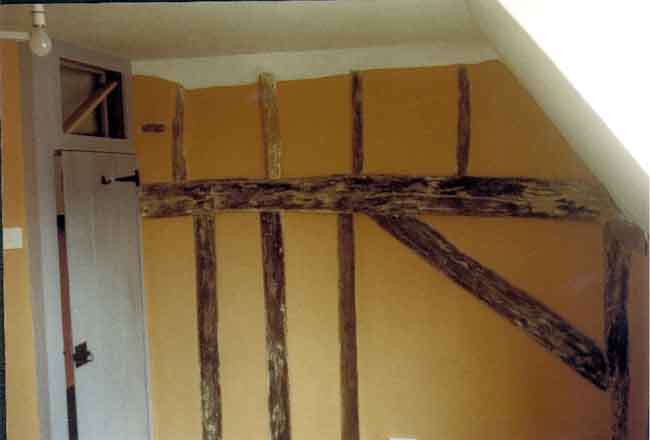
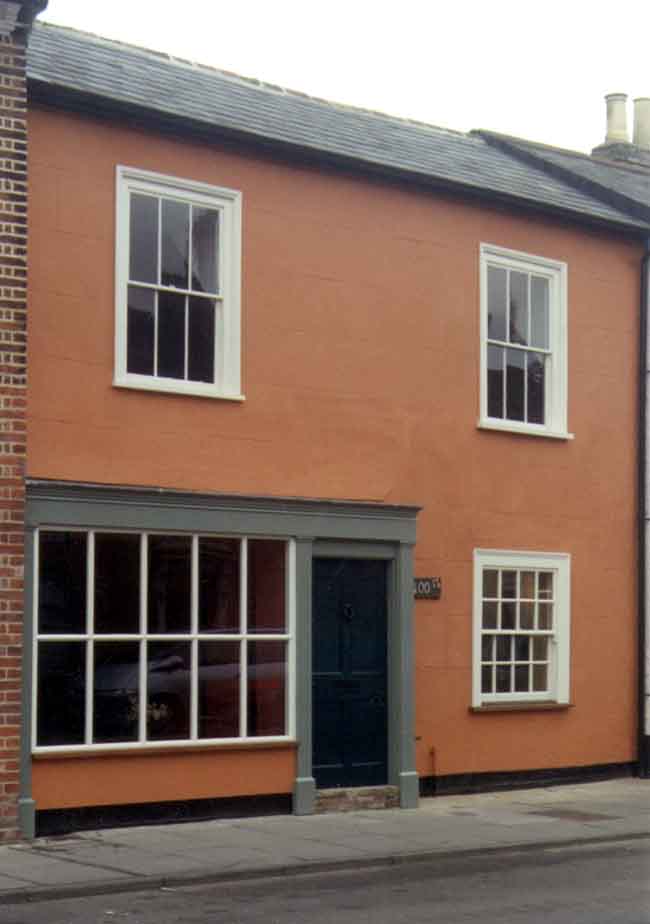 What
was discovered under the many layers of evolution was a 15th century medieval
hall to which a large hearth had been added in the 17th century. In the 18th
Century the building had been refronted, possibly at the time it was made into
a shop. The recent restoration has created a compact dwelling of considerable
charm having all modem facilities and which does much to enhance the
appearance of the Northern part of the High Street. By their low key but
effective approach to the project, which in other hands could have easily
suffered from over restoration or loss of character, Mrs. King and Mr. Hipkin
are to be roundly congratulated.
What
was discovered under the many layers of evolution was a 15th century medieval
hall to which a large hearth had been added in the 17th century. In the 18th
Century the building had been refronted, possibly at the time it was made into
a shop. The recent restoration has created a compact dwelling of considerable
charm having all modem facilities and which does much to enhance the
appearance of the Northern part of the High Street. By their low key but
effective approach to the project, which in other hands could have easily
suffered from over restoration or loss of character, Mrs. King and Mr. Hipkin
are to be roundly congratulated.
Sue Angland as
Treasurer reported the Society was running at a slight loss, leading to the
Executive Committee raising membership subscriptions by £1 per member (see
opposite).
Joe Byrne reported an
active year for the History Group, meeting at three-weekly intervals, and
continuing to work on the Town’s Archives.
Jan Byrne reported on
planning activities, including the continuing issue of Tesco and Buyright
applications. A group of five
members of the Executive Committee had prepared a submission to the District
Council, a copy of which was available for view.
The Society has been represented by Jan Byrne on the Town Forum and Sue
Angland on the Traffic Management Working Party.
In his review John
Bloomfield, one of the founding members together with John Griffin, looked
back over 18 AGMs and 160 meetings. Membership
was the highest ever at 200 and still growing. He thanked members for their
support, since it was important that they endorsed the work of the Executive
Committee. He concluded by
suggesting the Society should have a motto, and that ‘Constant Vigilance’
was more appropriate than ever.
Membership Rates
Following a proposal from the Executive Committee the AGM
approved Internet-based membership of the Society, with no charge, no
mailings, no free meetings and no vote. Such
members will be notified by e-mail and can access newsletters from the Society’s
website.
Having been unchanged for several years the Executive
Committee has made a small increase this year so that rates now stand as
follows.
|
Single member
|
£8
|
|
Joint members at same address
|
£12
|
|
Single life membership
|
£80
|
|
Joint life membership
|
£120
|
|
Full Time Students
|
£1
|
|
Senior Citizen
|
£6
|
|
Joint Senior
|
£8
|
The New Executive Committee
Under the ‘5 year’ rule there were several changes
to the Executive Committee this year.
|
Jan Byrne
|
Chairman
|
|
John Bloomfield
|
Vice
Chairman
|
|
Colin
Reeve
|
Treasurer
|
|
Sue Angland
|
Secretary
|
|
Joe
Byrne
|
History
Group
|
|
Bert
Keele
|
member
|
Rosemary
Schade
|
member
|
Gordon
Sutcliffe
|
member
|
Jim Betteridge
|
member
|
John
O'Brien
|
member
|
Mary
Howell
|
member
|
Graham
Panton
|
co-opted
|
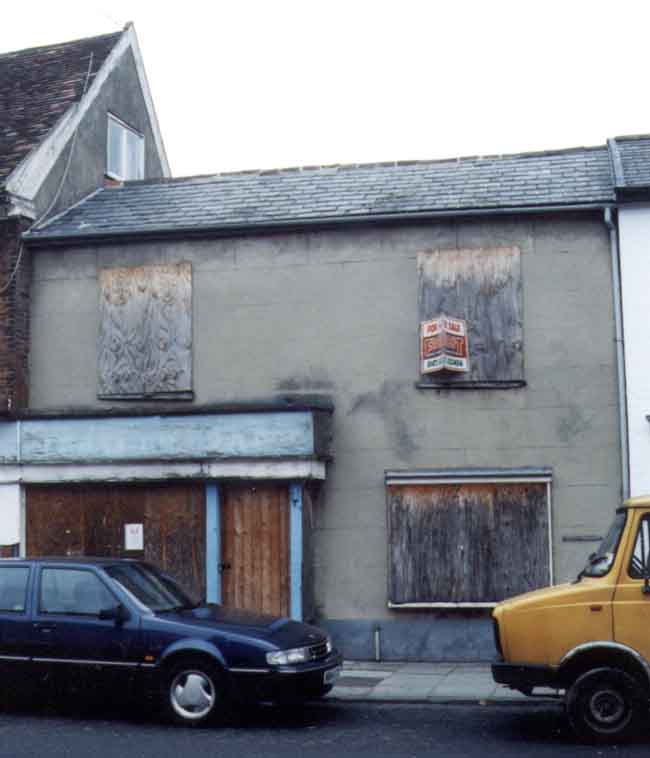

 What
was discovered under the many layers of evolution was a 15th century medieval
hall to which a large hearth had been added in the 17th century. In the 18th
Century the building had been refronted, possibly at the time it was made into
a shop. The recent restoration has created a compact dwelling of considerable
charm having all modem facilities and which does much to enhance the
appearance of the Northern part of the High Street. By their low key but
effective approach to the project, which in other hands could have easily
suffered from over restoration or loss of character, Mrs. King and Mr. Hipkin
are to be roundly congratulated.
What
was discovered under the many layers of evolution was a 15th century medieval
hall to which a large hearth had been added in the 17th century. In the 18th
Century the building had been refronted, possibly at the time it was made into
a shop. The recent restoration has created a compact dwelling of considerable
charm having all modem facilities and which does much to enhance the
appearance of the Northern part of the High Street. By their low key but
effective approach to the project, which in other hands could have easily
suffered from over restoration or loss of character, Mrs. King and Mr. Hipkin
are to be roundly congratulated.